4 Сustomer Segmentation Models for Content Personalization in 2024

An important condition for an effective marketing campaign is to deliver it to the right people at the right time with the right content. Creating a unique message for each potential and existing customer is challenging because their needs and preferences vary. Segmentation comes to the rescue, allowing companies to interact with users through personalized campaigns. The problem is that there is no universal approach to audience segmentation. You need to find the appropriate model that meets the needs of your business. In this article, we will discuss the most effective customer segmentation methods and provide tips on how to use them to personalize communication with customers and increase their engagement.
Why does a business need segmentation models
Customer segmentation is an opportunity to obtain valuable data about customers and tailor campaigns based on this data rather than just dividing people into groups. Why invest in audience segmentation:
1. Effective customer interaction
Segmentation models improve understanding of customer interests. By applying them in marketing, you can find effective ways to attract users. When you send relevant messages to your audience, you improve their customer experience, thereby increasing sales. Through segmentation and prioritizing communication, you can tailor each message to maximize its effectiveness.
 Example of a personalized letter from Sephora
Example of a personalized letter from Sephora
2. Increased advertising ROI
If there is only one marketing channel where customer segmentation brings impressive results, it is paid advertising. It is in the company's interest to address ads specifically to potential customers for whom it is relevant.
The main advantage of customer segmentation for advertising campaigns is the ability to focus more attention on groups that are more profitable, while reducing interaction with less profitable audiences.
For example, if an online store plans to promote a new collection of sunglasses, it should focus on user segments living in sunny regions or conduct the campaign during the summer season.
3. High email open rates and click-through rates
Understanding what users need and their preferences is the first step to effective segmentation.
With the help of mass mailing services, such as Altcraft Platform, you can create detailed contact segments based on specific data and launch personalized email campaigns. As a result, email open rates, click-through rates, conversion rates, and email ROI will quickly and significantly increase.
 Example of audience segmentation in Altcraft Platform
Example of audience segmentation in Altcraft Platform
4. Increased customer loyalty
Retaining existing customers is cheaper than acquiring new ones. By understanding what each segment expects, you can send them personalized messages with relevant content. This builds their trust and turns them into loyal customers. Through segmentation, maximum customer retention is achieved, and relationships with them are improved.
4 customer segmentation model
So, you're ready to start segmentation. But where to begin? The approach depends on the industry, goals, and customer journey.
1. Sociodemographic segmentation
The demographic segmentation model is one of the most popular among marketers. Therefore, it is among the first stages of customer segmentation strategy in any company. Such division groups people based on specific demographic characteristics:
- age
- gender
- education
- occupation
- income
- marital status

Demographic segmentation is highly effective for brands with a broad audience across various sectors, from e-commerce to media and fitness applications.
Let's consider a successful example from the Adidas Training app, where gender was taken as a segmentation criterion. After the user specifies their gender in the settings, the brand recommends an enhanced version of the service. To attract attention, female athletes are showcased during workouts to make the offer more relevant to the specific group, resulting in higher engagement.

For instance, suppose you need to promote a B2B application and its new feature. Then, you need to understand what a user from another company represents and tailor messages to their professional inquiries.
2. Segmentation by geolocation
Geolocation segmentation is considered one of the fundamental elements of content personalization, as it divides customers based on their location: country, city. This is ideal when your business operates globally or in two or more regions.
If users' geolocation is not automatically determined through the website or application, use the city or country that the person specified during registration, and based on this geodata, send individualized offers. Additionally, such information can be obtained through email surveys and quizzes on social networks.
Knowing where customers are located allows for tailored interactions and better service. How to do this? Everything comes into play: local slang, local news, and respect for local traditions.
Such messages demonstrate that you have thought out the marketing campaign and have special conditions specifically for a particular location. Also, segmentation by location allows for sending relevant emails or SMS messages taking into account customers' time zones. This makes it easier to attract them to offline stores, if available.
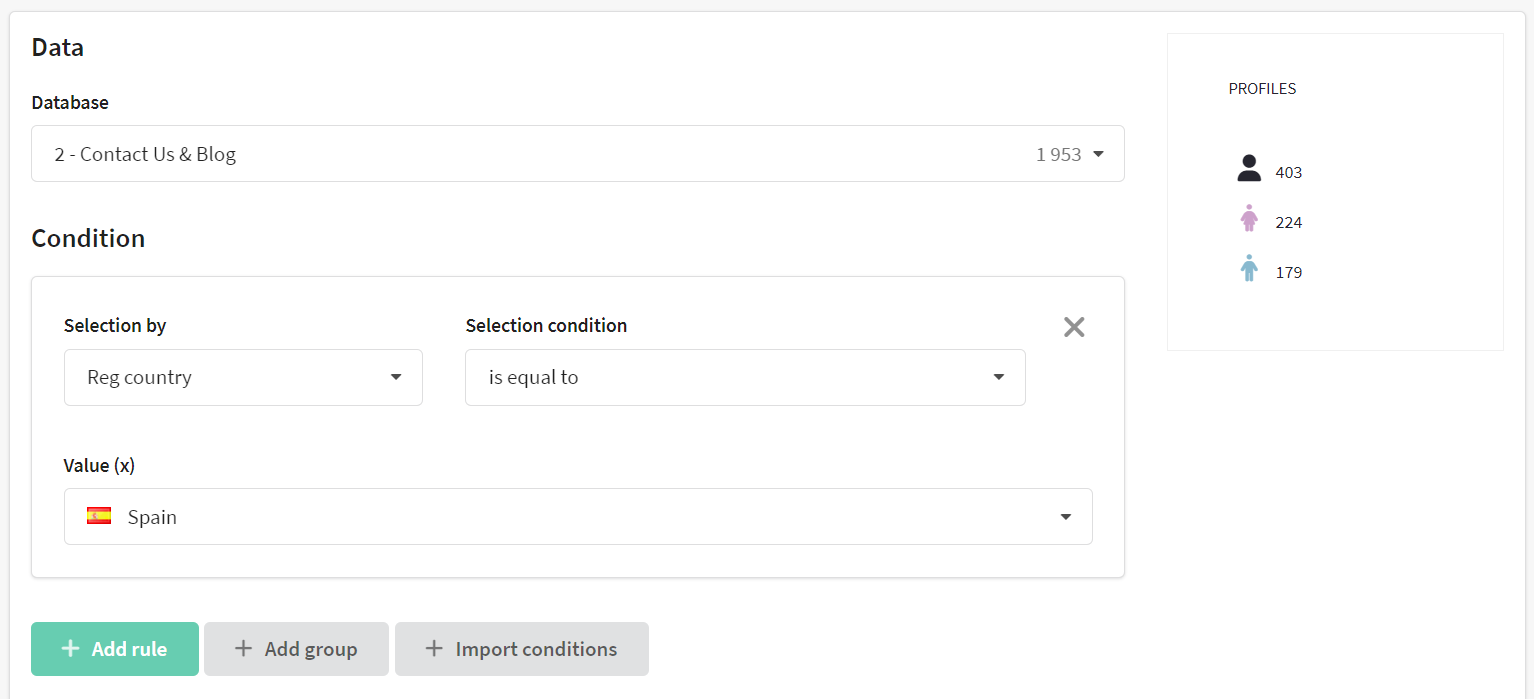 Example of audience segmentation by geolocation in Altcraft Platform
Example of audience segmentation by geolocation in Altcraft Platform
3. Behavioral segmentation
Demographic and geolocation information are good starting points for customer segmentation, but in most cases, understanding people's behavior – their interactions with your company – proves key to capturing users' attention. This can include browsing or purchase history on the website or engagement with email newsletters.
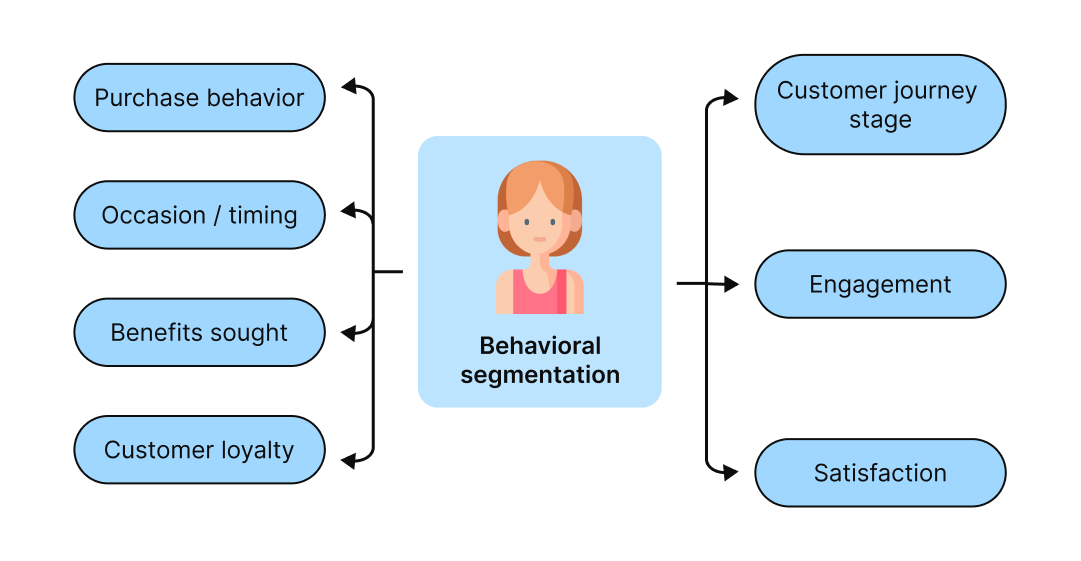
For example, different marketing strategies are needed for loyalty program participants and those who have interacted with multiple posts on social media. Behavioral segmentation enables the development of methods to attract each customer, re-engage former buyers, or engage those who have not yet made a purchase.
Through behavioral segmentation, the customer team identifies common issues and expands the knowledge base. For example, discovering a pattern among visitors who left the website because the ordering process was too complex. You can address many issues through a detailed database or by streamlining the ordering process.
4. RFM analysis
RFM segmentation (Recency, Frequency, Monetary) is a model for dividing the audience into groups based on three criteria: the recency of activity, the frequency of interaction, and the monetary value. This model is popular because it uses concise and objective data. Additionally, the information obtained from RFM analytics is easier to interpret. Such indicators of customer behavior are directly related to their value and engagement.
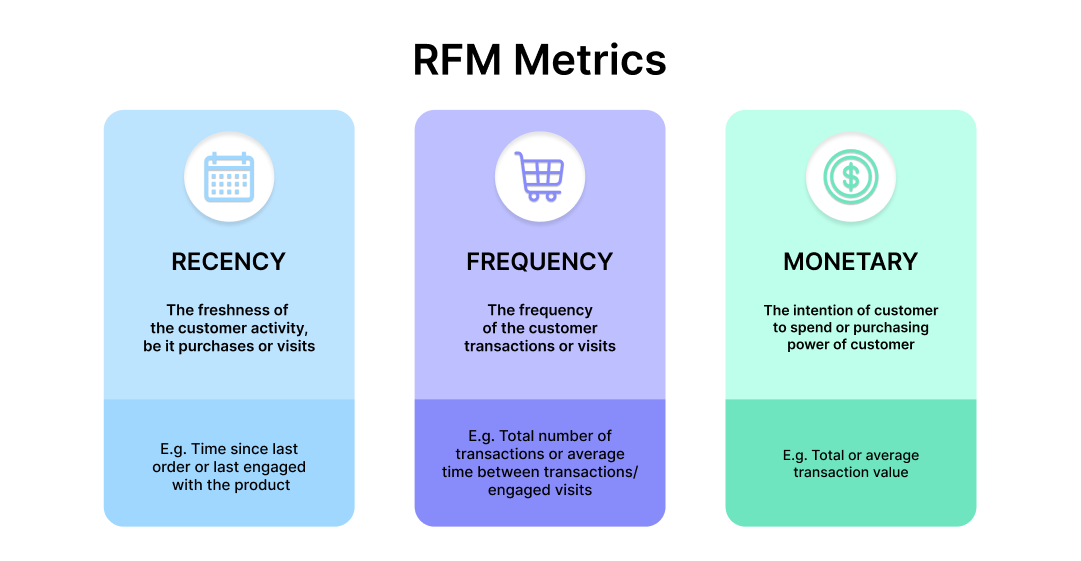
RFM analysis addresses key questions: who among the customers is likely to churn soon, and who will make a repeat purchase. For example, customers who have recently interacted with the company are more open to communication and promotions. People who frequently return to the brand are more engaged, making them loyal. And the customer's monetary value indicator helps the company identify specific segments: customers who make large purchases compared to those who spend little. Thus, by considering customer behavior, you will provide them with relevant content and increase responsiveness to your offers.
How to personalize content to reach customers
Regardless of how you segment your audience, you also need to understand how to personalize content for them and adhere to established rules.
1. Base decisions on data obtained directly from the user
Everyone talks about user privacy online. In the future, without cookie files, companies will have to rely entirely on the data voluntarily provided by the users themselves. These data can be collected in different ways: through forms on the website or in the application, various surveys, and polls. You can also simplify the collection of feedback on the product or service from customers who have used it.
Send users personalized content based on the data that the user wants you to know about them. This way, you will not mislead customers with knowledge of information they did not provide to you.
You should determine which segment is more important in terms of potential profit. Create a loyalty program for exclusive discounts only for those who reach a certain purchase threshold. This does not mean that you should neglect customers who make few purchases. Send them personalized product recommendations, special rewards. Or reduce costs for the segment by making customer service entirely automated.
2. Develop the onboarding process
Just as in life, in marketing, you can only make a first impression once. Therefore, it is important to attract users' attention and make an impact from the first minute of interaction. Ask for feedback or participate in a survey to gather valuable information about preferences and expectations. Customize the onboarding process according to the needs through customer path personalization.
Streaming services, such as Netflix, start the onboarding process immediately after a person registers on the platform. Customers indicate three favorite series so that the service can provide personalized recommendations for further viewing.
If you want even more personalized onboarding, add personalized video to the welcome email. It's not as difficult as it seems, as you can use the same script and make some changes based on the preferences and demographic data provided by the user during registration. But for small businesses, this is not an ideal option due to limited time frames and funding.
3. Develop personalized blog content
What is the main goal of creating a carefully crafted blog? To answer the audience's key questions. There is a lot of blog content on search engines, so you need to personalize your posts to truly address individual customer problems.
When you customize personalized article recommendations, you show readers the importance of addressing their pressing issues. As a result, the chances increase that visitors will start trusting the blog and returning for valuable content, and website traffic will grow.
Personalize the material according to specific segmentation criteria: demographic or reading history of the blog. For example, if a beauty brand wants to attract male customers, specific posts can be recommended: guides on grooming procedures for men, compilations of products to achieve specific skincare goals.
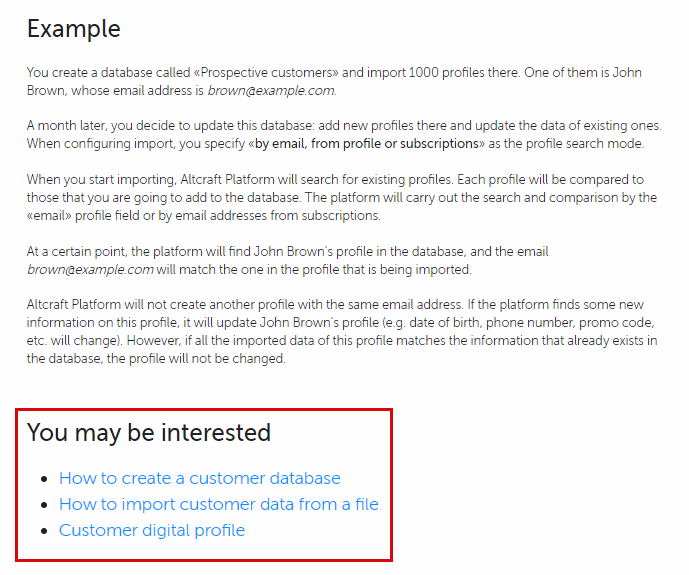 Personalized block in help center on Altcraft website
Personalized block in help center on Altcraft website
4. Embed dynamic content into emails and SMS
Dynamic content blocks are parts of emails or messages that adapt to the recipient's data. Using dynamic content saves marketers time in creating personalized email campaigns for each segment. This way, you create one email template, add dynamic content, and customize it for each segment. As a result, recipients feel that the brand is closer to them and cares about solving their personal problems.
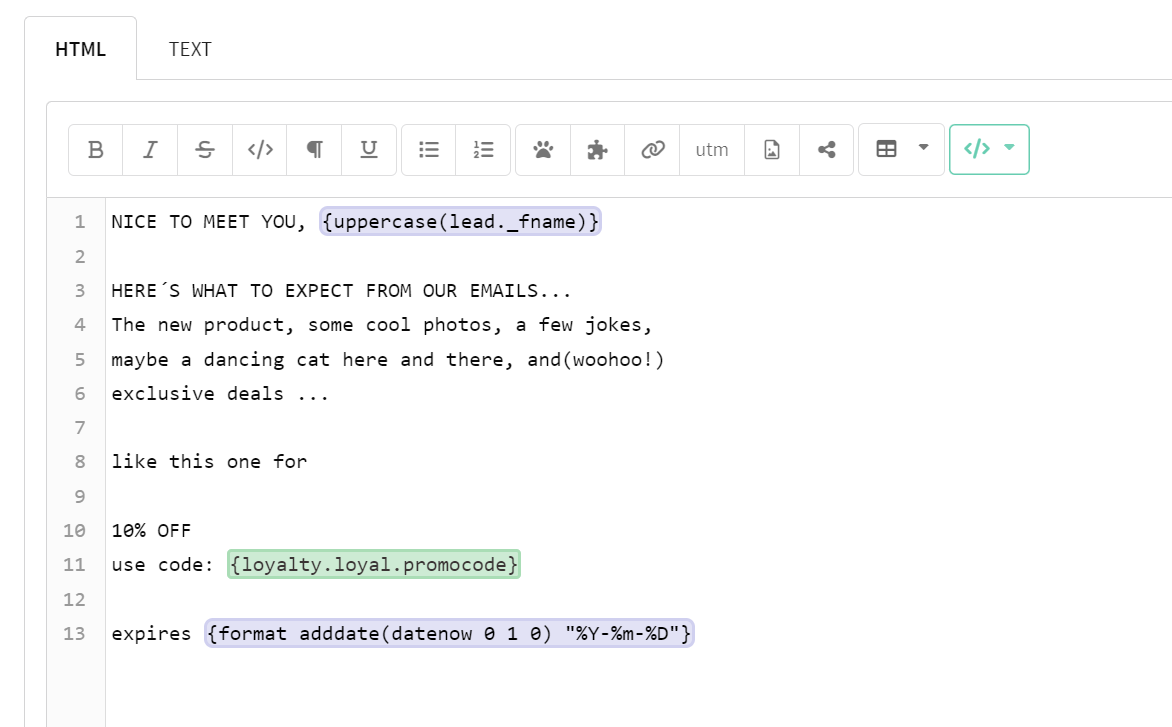

When you personalize your recipients' experience through automation, you free up time for your team to focus on more important tasks. Use dynamic visual elements to tailor emails to segments from different parts of the world. Another powerful way to use dynamic content is to replicate the sales funnel stage's CTA in the email for the segment currently at that stage.
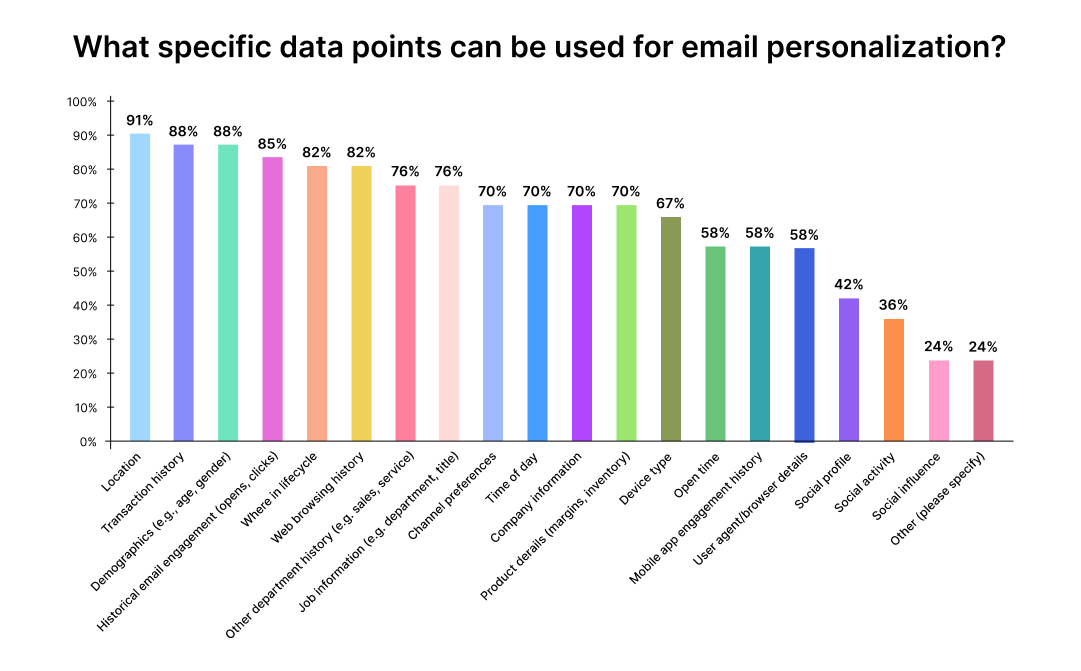
Exactly the same way, you can use dynamic content in push notifications and messages within mobile applications.
5. Track and analyze your action
All experienced marketers will tell you that there's no point in segmenting your audience and setting up campaigns if you're not evaluating the performance of your personalized communications. Otherwise, it's difficult to determine if your efforts are yielding the desired results. Track the performance of your personalized content—this way, you'll be able to make decisions on how to optimize the customer experience based on objective data.
There are several key performance indicators you should be monitoring: customer engagement and churn rate, conversion rates, and others. Determine which ones significantly impact your business goals and which ones do not.
Make sure to review your analytics regularly because customer needs change, and your business and customer base expand. This way, you'll stay informed about where to direct your optimization efforts.
Conclusion
Customer segmentation and content personalization are two reliable allies for businesses when it comes to creating and tailoring the customer journey. By selecting the most suitable segmentation model, you get closer to finely tuning marketing interactions with customers
By grouping users based on various criteria, you provide them with the personalized experience they expect. As a result, subscribers will respond to your campaigns and may return for new purchases.
Primary source: Only Influencers
You might be interested in:
Metaverses are often confused with virtual worlds and computer games, but the concept is broader. In this article, you will learn what metaverse is and why we need it.
Read moreThe SMS open rate reaches 98%, when the email open rate is only 20%. This is a good reason to introduce SMS into marketing.
Read moreHow to detect unauthorized access to information and what should be done in this case?
Read more